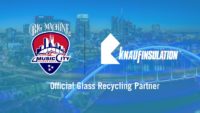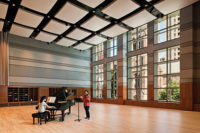The Music City Center, currently under construction in downtown Nashville is a multi-use convention facility designed to be Nashville’s next landmark building. It has a unique curvilinear design facade and features an extensive outdoor border of green space suitable for outdoor concerts and events. Adjacent to the Bridgestone Arena and the Country Music Hall of Fame, the Music City Center is just a short distance away from the Broadway area honky tonks where Nashville earned its reputation as “Music City”. Official groundbreaking for the project was held March 2010 and the new building is slated to open in early 2013.
Designed by Atlanta-based tvsdesign (formerly Thompson, Ventulett, and Stainback Associates) and Nashville-based Tuck Hinton Architects and Moody-Nolan Architects, the Music City Center has a total square footage including parking of 2.1 million square feet. The actual building will be 1.2 million square feet, featuring a 350,000 square foot exhibit hall, a 57,000 grand ballroom and 18,000 square foot junior ballroom, and about 1,800 parking spaces. It also offers 90,000 square feet of meeting room space.
A unique feature of the facility is the exterior facade of the building where a 65-foot difference in elevation from the northwest corner of the site to the southeast corner allowed the architects to incorporate dramatic horizontal and vertical curved elements into their design. Construction of the complex design involved the installation of one of the most dynamic linear metal ceiling systems in the country. The inconsistent finished elevations resulting from the sweeping curvatures in the system required constant adjustment in elevation when working throughout the system at heights of up to 143-feet. It was a complex challenge.
SAFE BUT HIGH HEIGHTS
With offices in nearby LaVergne, Tenn., and experience in successfully handling other difficult projects, Acousti Engineering Company of Florida bid on and landed the largest single contract of any local company on the Music City Center project when the multi-million dollar contract was awarded. Acousti was chosen to work on a number of activities including the installation of horizontal sub-ceiling framing, installation of vertical framing, erection of the carrier system and installation of the panels onto the carrier.
Acousti Engineering Co. of Florida was established in 1946 and quickly became a leader in the ceiling materials market. Today, the company is the largest interior construction company in Florida and one of the largest in the United States. With 20 locations throughout the Southeast, Texas and the Caribbean, the company offers a wide range of products and services for construction of ceilings, wall panels, flooring and other specialties.
To safely reach heights up to 143-feet and maintain the productivity necessary to complete the project within the allotted timeframe, one of the primary tools used by Acousti workers when installing the ceiling system was the JLG 1500SJ Ultra Boom, a 150-foot platform height telescopic boom lift. It is the tallest self-propelled boom lift of its kind and offers a greater work envelope and reach at elevated heights than any other machine currently available.
Because of the “newness” of the JLG 1500SJ, its greater capabilities and the limited availability in rental yards, Acousti rented machines from a number of rental companies including NES, Equipment Depot and Nashville High Reach to meet their needs. In addition to the machines that Acousti rented, other contractors at the site were using a variety of other machines including 120-foot and 135-foot Ultra Booms and articulating booms.
Before Acousti selected the machines for its overhead work several other systems for overhead access were considered but none had the flexibility of using a boom lift. One system that was given consideration was traditional scaffolding and another was a bridge platform system.
BOOM TIME
Because scaffolding was a fixed structure rather than a mobile machine like a boom lift and the ground level work area was limited in size, it would have prevented easy site access to other trades who needed to traverse the area or work overhead.
Says Mike Nimitz, Acousti’s project manager for the Music City Center, “Our decision to use the 150-foot boom lifts has relieved us of these time and cost constraints, enabling our highly skilled mechanics to focus their efforts on safely installing a unique system of fitting quality that is designed to be one of the main aesthetic features of this facility and the Nashville Skyline.”
Ceilings Plus of Los Angeles was given the task to design and fabricate the actual panels and backup systems. The company is known for having unique, custom-designed equipment that is computer driven through CAD language. This allows them to form metal panels with extreme accuracy and speed, thus dramatically lowering the cost to produce the specialty metal panels required for the Music City Center project. Once delivered to the job site, Acousti craftsmen were able to accurately place the panels and install them from the platform of the JLG boom lift.
Although the maximum working height at the site was only 143-feet, the 150-foot platform height machines had a maximum horizontal outreach of 80-feet which allowed workers to position the machine away from the structure to avoid ground level obstacles, yet still reach many overhead areas. The machines also incorporated three steering modes and advanced systems management to assist in positioning the platform.
Other features that helped workers access the many hard to reach overhead areas on the ceiling included a telescopic jib that extended up to 25 feet and had 120º vertical motion, a work platform with 180º hydraulic platform rotation and a 360º continuous turntable swing. To save time and increase productivity, the boom incorporated an on-board generator with an AC receptacle in platform to power hand tools, and provided 1,000-pounds unrestricted and 500-pounds restricted capacity in the 36-inch by 96-inch platform so workers could transport tools and materials to the overhead areas. It was the ideal machine for the job
While construction of the Music City Center is ongoing, most of the work left at the site doesn’t require the 150-foot platform height of the boom. For this work Acousti has rented a number of smaller JLG machines with lower platform heights. Said Acousti’s Nimitz, “The 150-foot machines allowed us to reach the overhead areas we needed to access and they did it safely and productively. Without them we would not have been able to perform our work as efficiently.” W&C







Report Abusive Comment